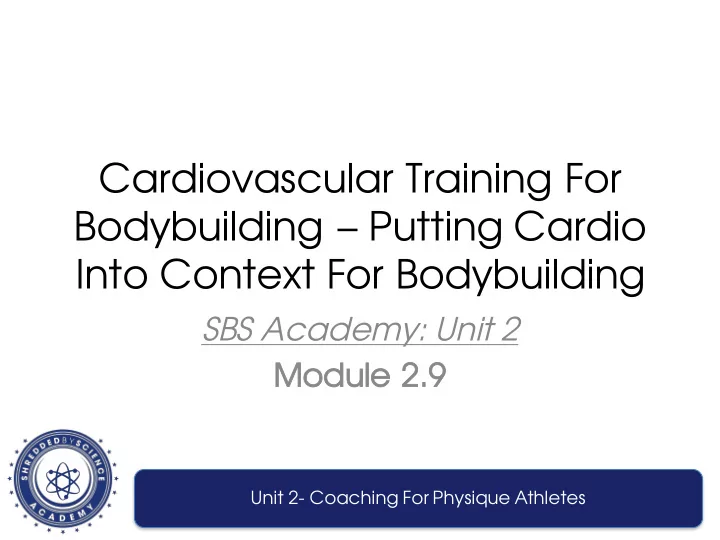

Cardiovascular Training For Bodybuilding – Putting Cardio Into Context For Bodybuilding SBS Academy: Unit 2 Mo Module le 2. 2.9 Unit 2- Coaching For Physique Athletes
Learning Objectives • Understand the role of cardiovascular training for physique competitors • Be able to describe the effects of concurrent training on skeletal muscle adaptation • Understand the pros and cons of various modes of cardiovascular training for physique competitors • Be able to develop a cardiovascular training plan for physique competitors Unit 2- Coaching For Physique Athletes
Ca Cardiovascular T Training fo for Bo Bodybuilding ng – Pu Putting Cardio in in Co Context fo for Bo Bodybuilding ng • Why do bodybuilders do cardio? Energy expenditure to achieve fat loss • – Other athletes try to achieve an adaptation Do we want this? • – Interference Endurance training is a competing adaptation • Relative to the volume and frequency of endurance • training Doesn’t reverse muscular adaptation, just reduces its • magnitude Can negatively impact power, strength and hypertrophy • Unit 2- Coaching For Physique Athletes
Ca Cardiovascular T Training fo for Bo Bodybuilding ng – Pu Putting Cardio in in Co Context fo for Bo Bodybuilding ng • Modes of Cardio – Interference affected by mode Cycling vs running….what’s the difference? • Impact, eccentric muscle actions • Joint stress and muscle damage • – Caloric expenditure Unfortunately, cycling has a low energy expenditure • Fortunately, cardio should not be our main vehicle for fat • loss 80% of deficit from caloric restriction…exceptions • Cycling is not the only form of low impact, low eccentric • cardio Unit 2- Coaching For Physique Athletes
Ca Cardiovascular T Training fo for Bo Bodybuilding ng – Pu Putting Cardio in in Co Context fo for Bo Bodybuilding ng • Modes of Cardio – Low Intensity Steady State (LISS) LISS is not endurance training • Energy expenditure is low • Interference is non existent if there is no adaptation • – Moderate Intensity Steady State (MISS) >60% VO2 Max • MISS something to miss out on, this is endurance training • Doesn’t need to be completely avoided, especially if • enjoyed Minimal at most • Unit 2- Coaching For Physique Athletes
Ca Cardiovascular T Training fo for Bo Bodybuilding ng – Pu Putting Cardio in in Co Context fo for Bo Bodybuilding ng • Modes of Cardio – High Intensity Interval Training (HIIT) – Pros Less time required comparatively for same energy • expenditure Reduced interference • Excess Post-exercise Oxygen Consumption (EPOC) • – Cons Higher intensity, higher stress • Impact and eccentric action still an issue • Unit 2- Coaching For Physique Athletes
Ca Cardiovascular T Training fo for Bo Bodybuilding ng – Pu Putting Cardio in in Co Context fo for Bo Bodybuilding ng • Modes of Cardio – High Intensity Interval Training (HIIT) – Cons continued Injuries in sprinters twice as high as runners (Lysoholm, 1987) • 10-60s all out, 30-120s rest, does this sound familiar? • – Barbell complexes Familiar mode, RBE • Enjoyment • Manage load 30-40% 1RM • Unit 2- Coaching For Physique Athletes
Cardiovascular T Ca Training fo for Bo Bodybuilding ng – Pu Putting Cardio in in Co Context fo for Bo Bodybuilding ng • Programming Cardio – Enjoyment Adherence and consistency important • Be creative, its just energy expenditure • – Limit the use of cardio 1-3 HIIT sessions, No more than 1 or 2 MISS sessions • LISS as needed but remember 80/20 rule • Add gradually NEAT & hormones (Redman, 2005; Novak, • 2007) Separate from weight training when possible • Unit 2- Coaching For Physique Athletes
Recommend
More recommend